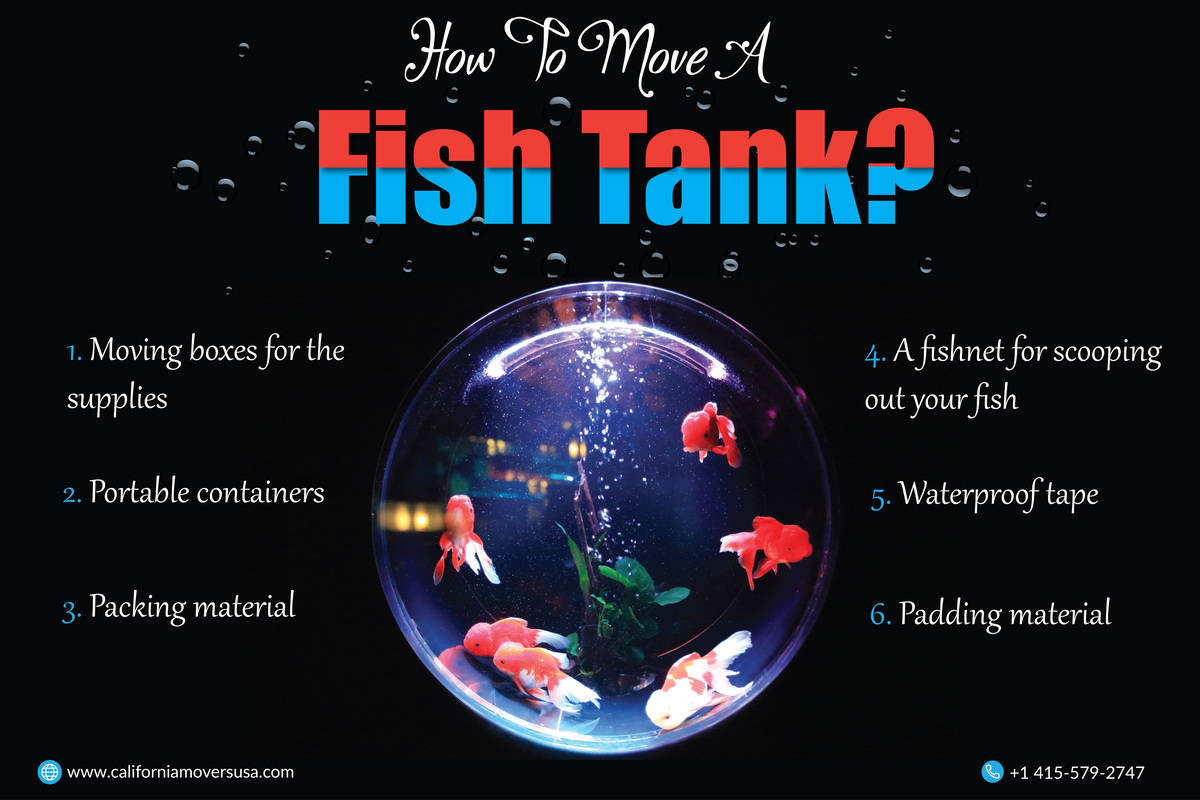How To Move a Fish Tank
To understand how to move a fish tank correctly and quickly, it is better to contact specialists for advice or use their services to move aquatic pets from one place to another. You can cut your effort in half (and yes, you too will have to learn a thing or two about how to move with fish) if you understand specifically what needs to be done to move a large fish tank and for transporting live fish. Ideally, you should never try and do such things on your own because you lack preparedness for the task at hand, no matter how many calculations you make and how much you try to prepare your mind. Home fish houses are stable and durable, but until they are moved, therefore, how to move a fish tank, you need to decide as soon as the question of moving arose and look for a reliable, experienced compan
Here’s what you need to do to move fish tanks:
Gather The Moving Supplies
Before you start, you need to gather all the essential supplies for the moving day and prepare a concise plan of operations. In short, be prepared for the whole thing, discuss it with your local movers . beforehand so you have a rough idea of what is about to happen and what you can do to make things smoother on your part. You’ll have to take out the décor and equipment from your large fish tank, and of course, the fish themselves.
But before you get moving, make sure you have the following:
- Portable containers, i.e., buckets, for your fish
- Plastic bags are also a nice alternative, but they only work for small fish and are prone to leaking, so tread with caution with them
- Portable plastic containers with lids or fish travel tanks are a decent choice as well
- Containers for your water plants (if you kept live plants inside your large fish tank)
- Waterproof tape (duct tape or packing tape) for securing lids of containers
- A fishnet for scooping out your fish from the tank
- A siphon hose for draining the tank
- Padding material such as air-filled plastic to cover your tank
- Moving boxes for the supplies
- Packing material
And so on…
Plus, note that if you’re transporting live fish, you probably have a ton of other things to relocate as well such as the food supplies, water testing kits, de-chlorinator, fish health items, and so on. Be sure you account for all of your supplies, both from within the tank and outside, before you finalize your moving a fish tank
Use A Fish Travel Tank or Transport Containers
Transporting live fish is a challenge of its own, you need to keep them in freshwater, ideally from the tank. Note that any abrupt changes in the water parameters and temperature will stress your fish out, and they'll most likely die as a result. So be sure it's not extremely cold outside. Depending on the distance to travel, you can either opt for plastic bags or portable tanks.
Aquarium moving is stressful for your fish, so you need to be extra cautious when moving fish tanks. Therefore, it is important to know in advance how to move an aquarium to a new house. Be sure that the water you've given to your fish to stay in, for the time being, is well aerated and that the environment is not crowded because that will only induce more stress.
Halt the feeding one day in advance so that your fish don't dirty the water during the move which can be troublesome because the buildup of toxic waste in a small confine can lead to lots of trouble. Don't panic about the health of your fish though, they can easily go for a day without food if you've fed them well before.
Preparing A Huge Aquarium for Transport
Next, you need to ready the aquarium itself for the move, and this part is perhaps even more complicated than moving with fish because large fish tanks can be bulky but fragile at the same time. However, don't worry, now you will learn how to properly Move an aquarium from house to house. Extreme caution is necessary if you wish to keep things in control, be sure you’ve properly secured your fish before you go through with the rest.
You’ll have to empty your tank first, stepwise. Start with live plants if you have any and put them in the water much like your fish, except there's not much to worry about with them. Next, start removing the decor pieces and equipment (be sure to unplug everything before you put your hand in the water).
Once you’ve taken out the décor, clean it gently, and then let the stuff dry out. The same goes for the sediment of the tank, i.e. the pebbles, stones, and sand you have placed at the bottom need to be taken out, washed gently (not very much because there are good bacteria on the sediment that are essential for the large fish tank ecosystem), and then dried. Once you’ve emptied the tank and packed the rest of the stuff, you then need to deal with the tank itself.
Remember, no soap!
Just wipe your tank clean with a cloth, make sure there are no chemicals involved, even in the slightest capacity, use only water. Once your tank is all empty and clean, start wrapping it up in padding of sorts like air-filled plastic, to be moved. It is best to let the local moving company handle the last part since a large fish tank is sufficiently bulky but fragile, so a single mistake here can be very costly.
Pack The Tank Before Moving
If you plan on packing the tank yourself, be completely prepared, though it is not recommended for giant fish tanks which are best handled by a group of long-distance moving professionals. You'll have to remove the lid and start wrapping the structure in some form of impact-resistant padding. Use duct tape or packing tape to secure the wrapping and place foam board insulation underneath the tank.
When placing the tank inside a moving box, to be placed inside the truck, be sure to insulate the sides with foam as well. Pick the box smartly, making sure that it is spacious enough but not too big to leave lots of extra space inside. Label the box properly, seal it and mark which side is up with arrows for your convenience.
Loading Safely on A Truck
Next, you need to load the tank onto the moving truck, a task yet again best left to long-distance moving professionals who'll ensure complete safety for your tank throughout. Huge fish tanks are hard to accommodate, so be sure you take extra care not to cause any damage.
Plus, don’t put anything on top of the container and fasten the rest of the movables too so your tank stays perfectly safe.
Setting Up the Tank, Again
Next, you’ll have to offload and unpack the tank at your new place, set it up somewhere where there is no glare or direct sunlight, and begin installing the effects.
The sediment goes in first, followed by some water (ideally some of it should be from the first time you drained the tank), live plants, décor pieces, and your fish tank equipment. Be very careful when dealing with fish tank heaters and oxygen pumps as these are electric components, in water, make sure that the switch is off when you have your hands in the water.
Once all has been set up perfectly, you can reintroduce your fish to the tank, carefully, and return to routine. I hope now you will know and will not get confused when you move giant fish tanks.


